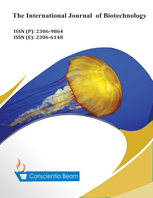Investigation of the Role of Two Bacterial Species in the Removal of Sulphate from Wastewater
Abstract
The aim of this study was to investigate the optimal conditions for sulphate from wastewater by Escherichia coli and Psendomonas aeruginosa under shake flask conditions. Before inoculating with the respective isolates, the wastewater was first filtered in 200 mL quantity into 250 mL capacity and then sterilized in an autoclave. After inoculation with the test isolates, aliquot wastewater samples was aseptically removed from each flask, every 24 h, for 96 h, for the estimation of sulphate concentration, using procedures. The results revealed sulphate removal at 35 oC and 45 oC while at 25 oC, an increase in sulphate level in the wastewater was observed at the end of the 96 h incubation period. This trend was irrespective of the test bacterial species. At the different pH, sulphate decreases of 50.31 %, 26.67 % and 18.14 % at pH 6, 8 and 10 were observed in the presence of the Escherichia coli while in the presence of the Pseudomonas aeruginosa, sulphate decreases of 31.53 % and 21.52 % were observed at pH 6 and 8, respectively. With the different concentrations of sodium acetate that were used for investigation, maximum sulphate removal was observed at 10 g/L. This trend was also irrespective of the test isolates. In presence of the different external carbon sources, sulphate concentrations in the wastewater after the 96 h incubation period were observed to increases at the expiration of incubation. Yeast and meat extracts were observed to enhance sulphate removal in the presence of the Escherichia coli while in presence of the Pseudomonas aeruginosa, remarkable sulphate removal was only observed when yeast extract was used as the nitrogen source. There was no decrease in sulphate level at the different concentrations of peptone that were investigated. This trend was common in presence of both isolates. The study was able to reveal the roles of temperature, pH, carbon and nitrogen concentrations and carbon/nitrogen sources on sulphate removal from wastewater by the test is bacterial species under the experimental conditions used for investigation.

